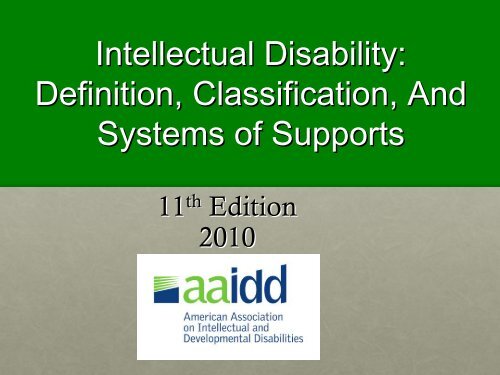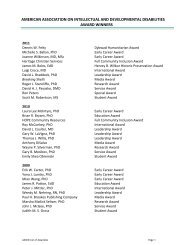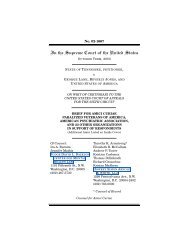Intellectual Disability: Definition, Classification, And Systems ... - aaidd
Intellectual Disability: Definition, Classification, And Systems ... - aaidd
Intellectual Disability: Definition, Classification, And Systems ... - aaidd
You also want an ePaper? Increase the reach of your titles
YUMPU automatically turns print PDFs into web optimized ePapers that Google loves.
<strong>Intellectual</strong> <strong>Disability</strong>:<br />
<strong>Definition</strong>, <strong>Classification</strong>, <strong>And</strong><br />
<strong>Systems</strong> of Supports<br />
11 th<br />
11<br />
Edition<br />
2010
•<br />
•<br />
•<br />
•<br />
•<br />
•<br />
•<br />
•<br />
•<br />
The AAIDD Ad Hoc Committee<br />
on Terminology and <strong>Classification</strong><br />
Robert L. Schalock<br />
Sharon A. Borthwick-Duffy<br />
Borthwick Duffy<br />
Valerie J. Bradley<br />
Wil H.E. Buntinx<br />
David L. Coulter<br />
Ellis M. (Pat) Craig<br />
Sharon C. Gomez<br />
Yves Lachapelle<br />
Ruth Luckasson<br />
AAIDD 2<br />
•<br />
•<br />
•<br />
•<br />
•<br />
•<br />
•<br />
•<br />
Alya Reeve<br />
Karrie A. Shogren<br />
Martha E. Snell<br />
Scott Spreat<br />
Marc J. Tassé Tass<br />
James R. Thompson<br />
Miguel A. Verdugo-Alonso<br />
Verdugo Alonso<br />
Michael Wehmeyer<br />
• Mark H. Yeager
The <strong>Definition</strong> of <strong>Intellectual</strong><br />
<strong>Disability</strong><br />
<strong>Intellectual</strong> disability is characterized by<br />
significant limitations both in intellectual<br />
functioning and in adaptive behavior as<br />
expressed in conceptual, social, and<br />
practical adaptive skills. This disability<br />
originates before age 18.<br />
AAIDD 3
Five Assumptions<br />
Regarding the <strong>Definition</strong><br />
1. Limitations in present functioning must be<br />
considered within the context of community<br />
environments typical of the individual’s individual s age<br />
peers and culture.<br />
2. Valid assessment considers cultural and<br />
linguistic diversity as well as differences in<br />
communication, sensory, motor, and<br />
behavioral factors.<br />
AAIDD 4
Five Assumptions<br />
Regarding the <strong>Definition</strong><br />
3. Within an individual, limitations often<br />
coexist with strengths.<br />
4. An important purpose of describing<br />
limitations is to develop a profile of needed<br />
supports.<br />
5. With appropriate personalized supports<br />
over a sustained period, the life functioning<br />
of the person with intellectual disability<br />
generally will improve.<br />
AAIDD 5
Conceptual Framework of Human<br />
Functioning<br />
6
Framework for Assessment<br />
Assessment<br />
Function<br />
Diagnosis<br />
Specific Purpose<br />
In order to:<br />
Establish presence<br />
or absence of ID<br />
Establish eligibility<br />
for services<br />
Establish eligibility<br />
for benefits<br />
Establish eligibility<br />
for legal<br />
protections<br />
AAIDD 7<br />
Examples of Measures, Tools,<br />
and Assessment Methods<br />
Intelligence tests<br />
Adaptive Behavior scales<br />
Documented age of onset<br />
Developmental measures<br />
Social history and<br />
educational records
Diagnostic Issues: Cutoff Score<br />
•<br />
•<br />
The score(s) that determines the boundaries of<br />
the “significant significant limitations in intellectual<br />
functioning and adaptive behavior” behavior criteria for a<br />
diagnosis of ID<br />
For both criteria, the cutoff score is approximately<br />
approximately<br />
two standard deviations below the mean of the<br />
respective assessment instrument, considering the<br />
standard error of measurement for the specific<br />
instrument used and the strengths and limitations of<br />
the instrument<br />
AAIDD 8
Diagnostic Issues:<br />
Standard Error of Measurement<br />
The standard error of measurement (SEM) refers to<br />
variation around a hypothetical 'true score' for the<br />
person. The SEM applies only to scores obtained from a<br />
standardized test and can be estimated from the<br />
standard deviation of the test and the test's reliability.<br />
The SEM, which varies by test, sub-group, and age<br />
group, should be used to establish a statistical<br />
confidence interval within which the person's true score<br />
falls. Reporting the range within which the person's true<br />
score falls rather than only a score, underlies both the<br />
appropriate use of intellectual and adaptive behavior<br />
assessment instruments and best diagnostic practices in<br />
the field of ID. Such reporting must be a part of any<br />
decision concerning the diagnosis of ID.<br />
AAIDD 9
Diagnostic Issues:<br />
Confidence Interval<br />
The statistical interval or range (based on the instrument’s<br />
instrument s<br />
standard error of measurement and properties of the<br />
normal curve) within which the person’s person s true score falls.<br />
From the properties of the normal curve, a range of<br />
statistical confidence can be established with<br />
parameters of at least one standard error of<br />
measurement (i.e., 66% probability) or parameters of<br />
two standard error or measurement (i.e., 95%<br />
probability).<br />
The selection of the confidence interval (i.e. 66% or 95%)<br />
relates to the question(s) asked, the properties of the<br />
assessment instrument used, and the ultimate use of the<br />
obtained score(s).<br />
AAIDD 10
Diagnostic Issues:<br />
Retrospective Diagnosis<br />
• Retrospective diagnosis may be<br />
necessary in situations where the<br />
individual did not receive an official<br />
diagnosis of intellectual disability during<br />
the developmental period.<br />
AAIDD 11
•<br />
•<br />
Retrospective Diagnosis Procedures<br />
Use the four clinical judgment strategies (pages 92-103) 92 103)<br />
• Understand the question,<br />
• Conduct or access a thorough history,<br />
• Conduct or access broad-based broad based assessments,<br />
• Synthesize the obtained information<br />
Follow the five retrospective diagnosis guidelines (page 96):<br />
• Be aware of legal findings and definitions, and needed clarifications<br />
clarifications<br />
• Be sensitive to language differences and culturally based behaviors behaviors<br />
and beliefs<br />
• Weigh the extent to which adaptive behavior assessments meet the<br />
five criteria<br />
• Weigh the extent to which intellectual functioning assessments meet meet<br />
the four criteria<br />
• Develop a contemporary assessment if necessary<br />
AAIDD 12
Assessment<br />
Function<br />
<strong>Classification</strong><br />
Framework for Assessment<br />
Specific Purpose<br />
In order to:<br />
Classify for intensity of<br />
needed support (s)<br />
Classify for research<br />
purposes<br />
Classify by selected<br />
characteristics<br />
Classify for special<br />
education supports<br />
Classify for<br />
reimbursement/ funding<br />
AAIDD 13<br />
Examples of Measures,<br />
Tools, and Assessment<br />
Methods<br />
Support needs intensity<br />
scales<br />
Levels of adaptive behavior<br />
IQ ranges or levels<br />
Environmental assessment<br />
Etiology-risk factor systems<br />
Mental health measures<br />
Benefit categories
<strong>Classification</strong><br />
The primary purposes of classification<br />
in the field of ID are grouping for:<br />
• Funding<br />
• Research<br />
• Provision of services and supports and<br />
• Communication about selected characteristics of<br />
persons and their environments<br />
AAIDD 14
<strong>Classification</strong><br />
As the field moves increasingly to an ecological<br />
focus, a supports paradigm, and the inclusion of<br />
persons with ID into the mainstream of life, a<br />
broader approach to classification is required<br />
than that used previously<br />
A multidimensional classification system is<br />
proposed in the 2010 Manual: <strong>Classification</strong><br />
based on intellectual abilities, adaptive behavior,<br />
health, participation, context, and the intensity of<br />
needed supports<br />
AAIDD 15
Assessment<br />
Function<br />
Planning<br />
and<br />
Developing<br />
Supports<br />
Framework for Assessment<br />
Specific Purpose<br />
In order to:<br />
Support to enhance<br />
human functioning<br />
Support to improve<br />
outcomes<br />
Support to help<br />
implement person’s<br />
choices<br />
Support to assure<br />
human rights<br />
AAIDD 16<br />
Examples of Measures, Tools,<br />
& Assessment Methods<br />
Person-Centered Planning;<br />
Self Appraisal;<br />
Ecological inventory;<br />
Developmental tests;<br />
Speech/language, motor, sensory<br />
assessment;<br />
Achievement tests;<br />
Support needs intensity scales;<br />
Functional behavioral<br />
assessment;<br />
Behavior support plan;<br />
Family centered support plan;<br />
IFSP, IEP, ITP;<br />
Self directed plan
Trends and Changes:<br />
Naming<br />
From mental retardation (1959)<br />
to intellectual disability (2010)<br />
AAIDD 17
Trends and Changes: Naming<br />
The term intellectual disability covers the same<br />
population of individuals who were diagnosed<br />
previously with mental retardation in number,<br />
kind, level, type, and duration of the disability<br />
and the need of people with this disability for<br />
individualized services and supports; and<br />
every individual who is or was eligible for a<br />
diagnosis of mental retardation is eligible for a<br />
diagnosis of intellectual disability.<br />
AAIDD 18
Trends and Changes:<br />
Defining<br />
1961 (Heber):<br />
Mental retardation refers to sub-average general<br />
intellectual functioning which originates during the<br />
developmental period and is associated with impairment<br />
in adaptive behavior.<br />
1973/1983 (Grossman):<br />
Mental retardation refers to significantly sub-average<br />
general intellectual functioning existing concurrently with<br />
deficits in adaptive behavior, and manifested during the<br />
developmental period.<br />
AAIDD 19
Trends and Changes:<br />
Defining<br />
1992 (Luckasson et al.):<br />
Mental retardation refers to substantial limitations in present<br />
functioning. It is characterized by significantly sub-average<br />
intellectual functioning, existing concurrently with related<br />
limitations in two or more adaptive skill areas. Mental<br />
retardation manifests before age 18.<br />
2002/2010 (Luckasson et al.; Schalock et al.):<br />
Mental retardation (intellectual disability in 2010) is a disability<br />
characterized by significant limitations both in intellectual<br />
functioning and adaptive behavior as expressed in conceptual,<br />
social, and practical adaptive skills. This disability originates<br />
before age 18.<br />
AAIDD 20
•<br />
•<br />
•<br />
Trends and Changes:<br />
<strong>Classification</strong><br />
Pre 1992 Manual: Manual:<br />
<strong>Classification</strong> based on IQ<br />
ranges (e.g. mild, moderate, severe, profound)<br />
1992/2002/2010 Manuals: Manuals:<br />
<strong>Classification</strong> system<br />
based on intended purposes (funding, research,<br />
provision of services and supports, and<br />
communication about selected characteristics of<br />
persons and environments)<br />
2010 Manual: Manual:<br />
Multidimensional <strong>Classification</strong><br />
System (intellectual abilities, adaptive behavior,<br />
health, participation, and context)<br />
AAIDD 21
•<br />
•<br />
•<br />
Trends and Changes:<br />
Planning Supports<br />
Concept of supports first introduced in 1992 Manual<br />
2002 Manual: Manual:<br />
The concept of supports expanded<br />
from a concept to a framework for assessment,<br />
planning/ implementation, and evaluation<br />
2010 Manual: Manual:<br />
Presented a systems of supports that<br />
involves organization systems, incentives, cognitive<br />
supports, tools, physical environment,<br />
skills/knowledge, and inherent ability<br />
AAIDD 22
Mismatch of<br />
competency and<br />
demands<br />
People with ID<br />
experience a<br />
mismatch<br />
between their<br />
personal<br />
competency and<br />
environmental<br />
demands<br />
Planning Supports<br />
Individualized<br />
Supports<br />
Thoughtful<br />
planning &<br />
application of<br />
individualized<br />
Supports<br />
AAIDD 23<br />
Improved<br />
personal<br />
outcomes<br />
May include<br />
more<br />
independence,<br />
better personal<br />
relationships,<br />
enhanced<br />
opportunities to<br />
contribute to<br />
society
Component 1:<br />
Identify desired life<br />
experiences and goals<br />
Component 3: Develop the<br />
Individualized Support Plan<br />
Component 4: Monitor Progress<br />
24<br />
Component 2:<br />
Determine<br />
the Intensity<br />
of Support Needs<br />
Component 5: Evaluation
•<br />
•<br />
•<br />
Additional Areas Covered<br />
in Manual<br />
Etiology: Etiology:<br />
A multifactorial approach (Chapter<br />
6)<br />
Clinical Judgment: Judgment:<br />
A component of<br />
professional responsibility; clinical judgment<br />
strategies; clinical judgment in retrospective<br />
diagnoses (Chapter 8)<br />
Prevention as a form of support and relating<br />
etiology to prevention and support (Chapter<br />
10)<br />
AAIDD 25
•<br />
•<br />
Additional Areas Covered<br />
in Manual<br />
Mental and physical health<br />
related supports, supports,<br />
including a community health supports model<br />
and comprehensive community health support<br />
standards (Chapter 11)<br />
Support needs<br />
of persons with ID who have<br />
higher IQ scores (Chapter 12)<br />
AAIDD 26
•<br />
•<br />
•<br />
Implications<br />
For Public Policy (Chapter 13)<br />
For Education (Chapter 14)<br />
For Support Provider<br />
Organizations (Chapter 15)<br />
AAIDD 27
The 2010 AAIDD <strong>Definition</strong>,<br />
<strong>Classification</strong>, & <strong>Systems</strong> of Support<br />
A systematic approach to the diagnosis,<br />
classification, and systems of supports for<br />
persons with ID described in the 2010<br />
Manual.<br />
The approach is based on current knowledge<br />
regarding the etiology of ID and an<br />
ecological, multidimensional framework that<br />
is used as a basis of assessment,<br />
classification, and developing individualized<br />
systems of supports.<br />
AAIDD 28
•<br />
•<br />
•<br />
•<br />
•<br />
Conclusion<br />
Thank you for your interest and attention<br />
Please provide feedback (evaluation sheet)<br />
For more information on the 11 th<br />
contact AAIDD (www.<strong>aaidd</strong>.org<br />
( www.<strong>aaidd</strong>.org) )<br />
or books@<strong>aaidd</strong>.org<br />
AAIDD 29<br />
edition<br />
th edition<br />
or www.<strong>aaidd</strong>.org/intellectualdisabilitybook/<br />
content2678.cfm?navID=282




